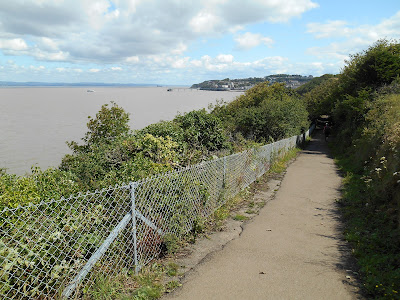The town of Clevedon has connections to two of England’s best known poets. Poets’ Walk is a popular footpath which runs along the coast and around Wain’s Hill and Church Hill at the southern end of Clevedon. The walk is said to have inspired poets such as Alfred Tennyson, Samuel Taylor Coleridge and William Makepeace Thackeray, who visited the town. The formal path which exists today was constructed in 1929. Poets’ Walk was designated as a Local Nature Reserve in 1993.
Poets' Walk signpost
The Sugar Lookout
is a feature on Poets’ Walk. It was built by Ferdinand Beeston in around 1835. It is said to have been used in the mid-19th
century by a family of sugar importers called Finzel to look out for ships
sailing up the Bristol Channel, which were carrying sugar from the West
Indies. It later fell into ruin but has
recently been restored.
Sugar Lookout overlooking the Bristol Channel
In the mid-18th century the author William Makepeace Thackeray was a
frequent visitor of the Elton Family, who lived at Clevedon Court. He is best known as a novelist but he did
also write some poetry.
Alfred Tennyson had a close friend at Cambridge University called Arthur Hallam. Arthur’s mother was a member of the Elton family of Clevedon Court. Arthur, who was a poet and essayist, was engaged to marry Tennyson’s sister Emily but he died suddenly in Vienna in 1833 at the age of 22. His body was brought back to England and he was buried in the family vault at St Andrew’s Church in Clevedon. In 1850 Tennyson wrote a poem called In Memorium in tribute to his friend. In the same year he made his first visit to Clevedon. The house on Old Church Road in Clevedon, where he is said to have stayed, is called Tennyson House. A nearby road is called Tennyson Avenue.









No comments:
Post a Comment